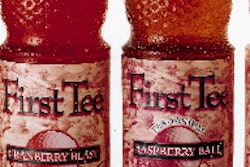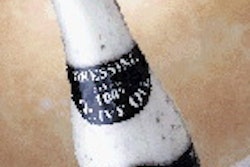They do this with the expectation that the final, commercial version of the program will be better than the beta version, modified--perhaps even totally rewritten--in response to the criticism and suggestions endured in its beta phase.
Two American brewers--Miller Brewing Co., Milwaukee, WI, and Anheuser-Busch, Inc., St. Louis, MO--are putting two different plastic bottles through a similar beta test process.
Miller Brewing has been at it longer, about five months, and has received some intense, withering criticism of its beta package. The trio (1 L, 20 oz, 16 oz) of amber bottles from Owens-Illinois' Continental PET Technologies (Florence, KY) are composed of five alternating layers of polyethylene terephthalate and MXD6 nylon into which an oxygen scavenger is dispersed. The bottle is capped with a 38-mm aluminum roll-on closure and labeled with metallized paper neck and body labels (see Packaging World, Dec. '98, p. 71, or packworld.com/go/beer). People with an interest in recycling have criticized every one of those packaging elements.
A-B waited for the environmental uproar over Miller's bottle to die down a bit before introducing its own plastic bottle (shown), a 16-oz, 211 dia long neck that stands 91/2" high--11/2" taller than Miller's 215 dia, 8" tall 16-oz bottle. Both bottles have champagne bases. Bud's features a distinctive tapered neck ring, designed to give the bottle a better "mouth feel."
After first talking with waste reclamation authorities in Dallas, TX, and Phoenix, AZ, A-B began testing the plastic bottles for cold-filtered Budweiser and Bud Light beers in convenience stores: 7-11s in Dallas and Circle Ks in Phoenix. For A-B, the test market introduction of cold-filtered versions of its top-selling pasteurized beers is a more radical development than the test marketing of another plastic bottle. Pasteurized Bud was test marketed in bottles of polyethylene naphthalate last year (see PW, Sept. '98, p. 128 or packworld.com/go/beer).
While Busch may or may not have changed aspects of its package on the basis of what it learned from the flak Miller's bottle encountered, the wait confirmed something A-B management already knew: When it comes to packaging, the environmental community--particularly recyclers--doesn't like surprises.
Having succeeded in requiring the Federal regulatory bureaucracy to consider the environmental impact of any new regulations--and defer those regulations if the impact is considered too great--waste handlers and container recyclers expect no less from consumer goods manufacturers. Recyclers are a practical bunch who operate in a precarious economic environment. When they are surprised by developments that fall short of their expectations, they aren't afraid to raise a little ruckus in order to remind packagers that post-consumer package handling is an issue that still has some political life in it.
"Speculation suggests that the plastic beer bottle will make major inroads displacing either glass bottles and/or aluminum cans for non-premium brands, depending upon consumer acceptance," writes the Plastic Redesign Project, a Madison, WI-based alliance of recycling officials from 32 states. But, in its working paper entitled "The Potential Impacts of Plastic Beer Bottles on Plastics Recycling," issued just two months after Miller's plastic bottle debut, the alliance says: "Less often discussed is how recyclers will react to the new designs in plastic bottles that are being considered for beer in view of the present precarious state of plastics recycling. This may be another limiting condition for new packages because, with the current mix of bottle designs and processing structures, the cost to handle recycled plastic exceeds the price of virgin resin during market downturns. That is not an economically sustainable cost picture. Any additional costs to process used plastic bottles imposed by a new design for a major application such as beer could create precipitous cost pressures on plastics recycling."
A-B's current beta plastic bottle, co-injection/stretch blow-molded by Twinpak, Inc. (Mississauga, Ontario, Canada) is an amber, 39-g three-layer bottle sandwiching Amosorb® 3000, a copolymer oxygen scavenger from BP Amoco (Chicago, IL), between layers of PET. Like Miller's plastic bottle, A-B's is capped with an aluminum roll-on closure from Silgan Container Corp. (Woodland Hills, CA).
But A-B's cap differs from Miller's in three ways. First, A-B's cap has a liner that uses a second oxygen scavenger: Darex OST from Darex Container Products (Lexington, MA). Miller's cap liner doesn't use an O2 scavenger. Second is size. Busch is using a less-expensive 28-mm closure, compared to Miller's 38-mm cap. Finally, the Bud caps feature what's called an eight-score, tamper-evident band. When the cap is untorqued, the scores around the perimeter of the band break away from the bottle and stay with the cap. Recyclers still prefer plastic caps on plastic bottles. But, of the two aluminum cap designs, recyclers like the one that doesn't leave a ring around the neck of the bottle.
As PW goes to press, recyclers haven't yet voiced an opinion on the new Bud bottles. But, in a way, it doesn't matter. The bottle you'll find in Dallas and Phoenix isn't the one of Anheuser-Busch's dreams. That bottle--economically competitive, able to withstand pasteurization, able to be filled, capped, labeled and cased at speeds comparable to or faster than glass bottle line speeds--doesn't exist yet. When it does, Anheuser-Busch will work hard to make sure the specification satisfies the needs of its consumers, its production operations, retailers and other vendors and, ultimately, the recycling community.


























